The GIGABYTE X470 Gaming 7 Wi-Fi Motherboard Review: The AM4 Aorus Flagship
by Gavin Bonshor on July 26, 2018 8:00 AM EST- Posted in
- Motherboards
- AMD
- Gigabyte
- AORUS
- Ryzen
- X470
- Ryzen 2
- Gaming 7 Wi-Fi
- Gaming 7
System Performance
Not all motherboards are created equal. On the face of it, they should all perform the same and differ only in the functionality they provide - however, this is not the case. The obvious pointers are power consumption, but also the ability for the manufacturer to optimize USB speed, audio quality (based on audio codec), POST time and latency. This can come down to manufacturing process and prowess, so these are tested.
Power Consumption
Power consumption was tested on the system while in a single ASUS GTX 980 GPU configuration with a wall meter connected to the Thermaltake 1200W power supply. This power supply has ~75% efficiency > 50W, and 90%+ efficiency at 250W, suitable for both idle and multi-GPU loading. This method of power reading allows us to compare the power management of the UEFI and the board to supply components with power under load, and includes typical PSU losses due to efficiency. These are the real world values that consumers may expect from a typical system (minus the monitor) using this motherboard.
While this method for power measurement may not be ideal, and you feel these numbers are not representative due to the high wattage power supply being used (we use the same PSU to remain consistent over a series of reviews, and the fact that some boards on our test bed get tested with three or four high powered GPUs), the important point to take away is the relationship between the numbers. These boards are all under the same conditions, and thus the differences between them should be easy to spot.
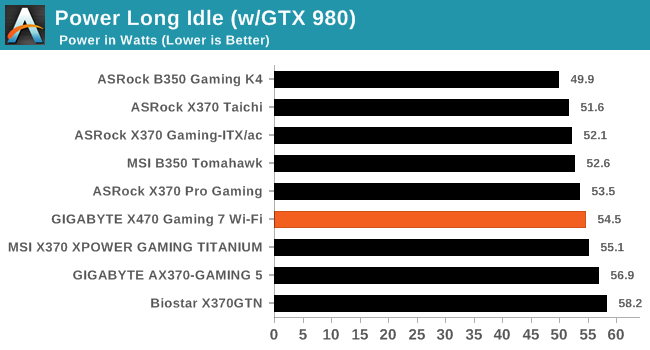
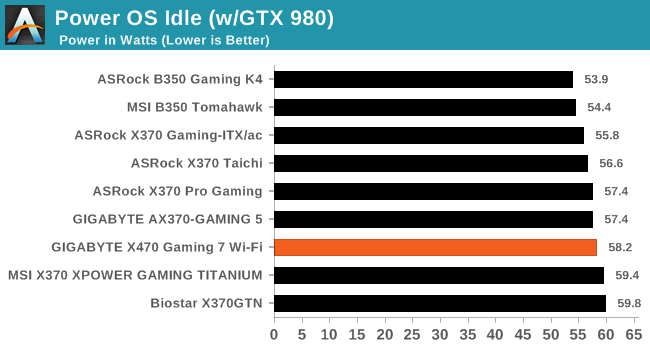
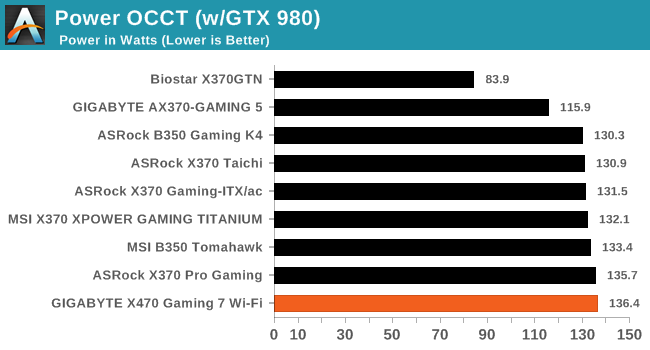
While one of the main benefits of X470 over the previous X370 chipset is a slight reduction in TDP under load, that hasn't been noticeable here as the Gaming 7 Wi-Fi is notable power hungrier than any other AM4 board.
Non-UEFI POST Time
Different motherboards have different POST sequences before an operating system is initialized. A lot of this is dependent on the board itself, and POST boot time is determined by the controllers on board (and the sequence of how those extras are organized). As part of our testing, we look at the POST Boot Time using a stopwatch. This is the time from pressing the ON button on the computer to when Windows starts loading. (We discount Windows loading as it is highly variable given Windows specific features.)

Alongside the ASRock X370 Gaming-ITX/ac small form factor motherboard, the GIGABYTE X470 Gaming 7 Wi-Fi makes a good impression on boot times compared to other AM4 motherboards previously tested. There wasn't much difference between stock settings and with all the malleable controllers disabled, somewhat marginal at best.
Rightmark Audio Analyzer 6.2.5
Rightmark:AA indicates how well the sound system is built and isolated from electrical interference (either internally or externally). For this test we connect the Line Out to the Line In using a short six inch 3.5mm to 3.5mm high-quality jack, turn the OS speaker volume to 100%, and run the Rightmark default test suite at 192 kHz, 24-bit. The OS is tuned to 192 kHz/24-bit input and output, and the Line-In volume is adjusted until we have the best RMAA value in the mini-pretest. We look specifically at the Dynamic Range of the audio codec used on the rear panel of the board.
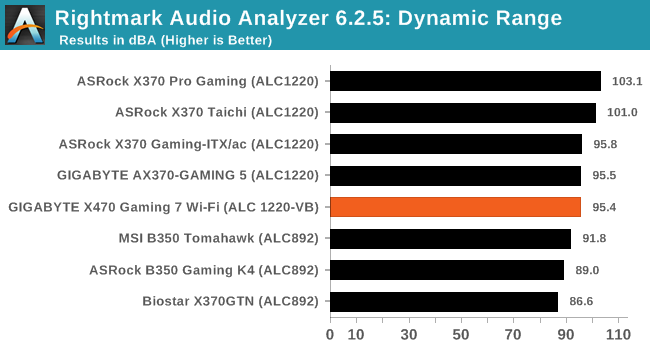
As the results show in RMAA 6.2.5's Dynamic range testing, the newly launched GIGABYTE X470 Gaming 7 Wi-Fi sits at the bottom of Realtek ALC1220 pile, despite being the later ALC1220-VB codec.
DPC Latency
Deferred Procedure Call latency is a way in which Windows handles interrupt servicing. In order to wait for a processor to acknowledge the request, the system will queue all interrupt requests by priority. Critical interrupts will be handled as soon as possible, whereas lesser priority requests such as audio will be further down the line. If the audio device requires data, it will have to wait until the request is processed before the buffer is filled.
If the device drivers of higher priority components in a system are poorly implemented, this can cause delays in request scheduling and process time. This can lead to an empty audio buffer and characteristic audible pauses, pops and clicks. The DPC latency checker measures how much time is taken processing DPCs from driver invocation. The lower the value will result in better audio transfer at smaller buffer sizes. Results are measured in microseconds.
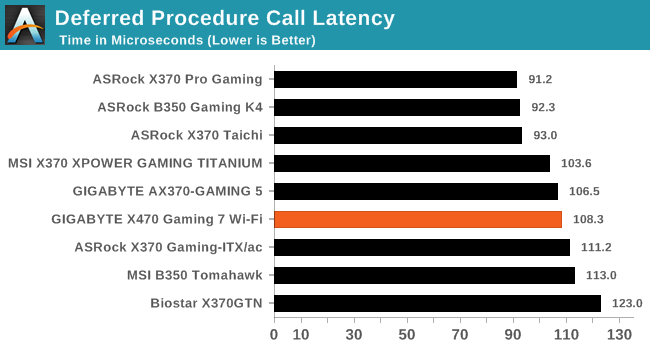
None of the manufacturers AM4 offerings tested so far including the X470 Gaming 7 Wi-Fi are optimized for DPC latency, but the Gaming 7 Wi-Fi does put in a very respectable showing.










29 Comments
View All Comments
vkristof - Friday, July 27, 2018 - link
So, it's middle of 2018, we a newish top-end AM4 "chipset" - WHY do we still only have two USB 3.1 10 Gbps ports on the rear panel?And why are they STILL not using USB 3.1 10 Gbps controllers/phys in the X470?
I'm not a gamer AT ALL and I buy cost effective HW AND I still fall for the AM4 "chipset" descriptions that list x amount of USB 3.1 Gen 2/10 Gbps controllers in the B350, B450, B370, B470 "Chipsets".
Why an extrenal Asmedia USB 3.1 Gen2/10 Gbps controoler and not the AMD "chipset" itself???
utmode - Friday, July 27, 2018 - link
instead putting RGB light they could have put more fan connector.Flappergast - Saturday, July 28, 2018 - link
Why is this board get 5% less fps compared to the msi b350 - this board is for high end and 5% is a lot extra if you are looking at SLI - and I dot see why you would not at this price pointMarkPhantasy - Sunday, July 29, 2018 - link
Hi,Thanks for sharing this awesome content.
Have a nice day.
http://intermediateresult2018.online/
Dug - Thursday, August 2, 2018 - link
Can we please get some m.2 and ssd benchmarks along with network benchmarks.And why are you using an older chip on new hardware? Can't Anandtech purchase a 2700x or 2800x?
How about sound? Any measurements or at least some tests would be nice.
4 year old graphics card?
How about tests with both m.2 slots filled with a x16 graphics card to see if there is any performance hit?
Mikewind Dale - Friday, February 1, 2019 - link
"And why are you using an older chip on new hardware? Can't Anandtech purchase a 2700x or 2800x?"Probably because they want to keep their benchmark results inter-comparable. If they already have benchmark scores using a 1700 and an X370, then they want to be able to show how much faster the X470 is than the X370 using the same processor (the 1700).
The purpose of a test bed is to keep every component the same except the one component being reviewed. So that means refraining from frequent upgrades to the test bed. If they constantly upgraded the test bed every time a new product came out, then none of the benchmarks would mean anything.
Oxford Guy - Friday, August 10, 2018 - link
"This is apparent as the X470 Gaming 7 has support for DDR4 memory up to speeds of DDR4-3600"Patriot guaranteed 3400 speed in July of 2017, even on B350 and A320 boards with Ryzen 1. This isn't so impressive, the idea that someone should fork over so much cash for a small bump over that.
As for the heatsink... We all know that ASUS came out with a hybrid water/air VRM sink back in 2013 and Gigabyte also later released the same thing — but only for Intel. Funny how even Threadripper isn't important enough to get the kind of board tech ASUS and Gigabyte gave quad core CPUs, before LED lighting and ugly paint jobs was supposed to substitute for substance.
vikkadhamtan - Saturday, August 18, 2018 - link
<a href="https://www.rsmssbldcresult.in/">RSMSSB LDC Result 2018</a>